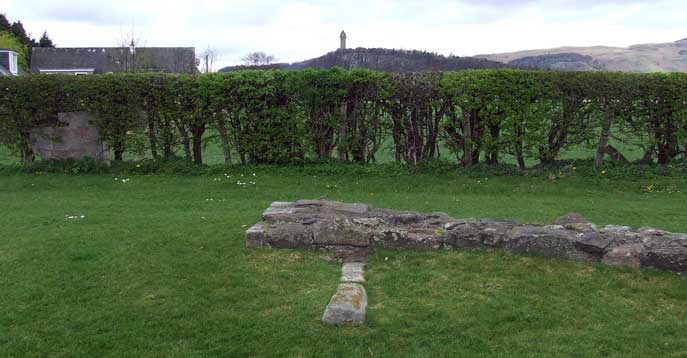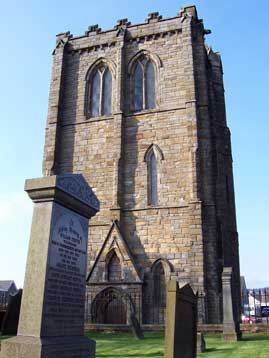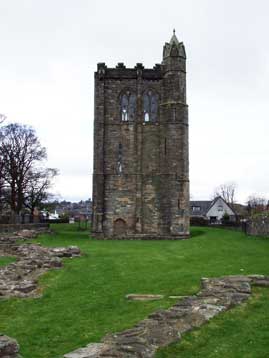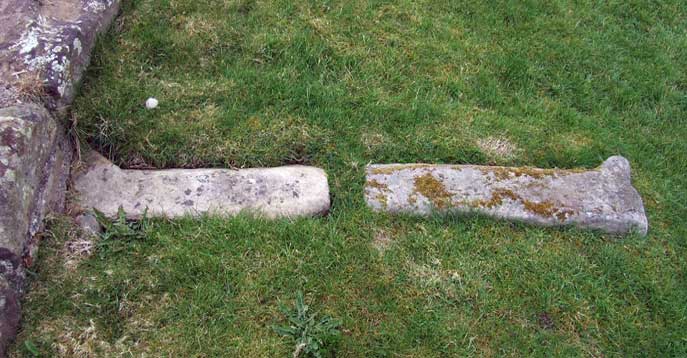SIR WILLIAM WALLACE'S BURIAL PLACE? |
 |
|
| We all know the story of Wallace’s betrayal by Monteith at Robroyston, and his subsequent removal to London to be executed for alleged treason in the most barbarous method possible. He was sentenced to be hanged, drawn and quartered, a peculiarly English ritual which was supposed to ensure that the 'guilty' could not rise again on Judgement Day - vengeance even beyond the grave. His head was spiked on London Bridge, and the four quarters of his mutilated body displayed in Newcastle, Berwick, Perth and Stirling, as a warning to all who transgressed against the rule of Longshanks. And there his story ended – with no final resting place for Scotland’s best-known hero. Or did it? Wallace's maternal uncle was a member of the priesthood, at Dunipace by Stirling, whose original residence was at one time Kilspindie, in the Carse of Gowrie. It was due to his influence that Wallace was said to have been educated in Dundee, along with John Blair who became his chaplain and biographer, where according to Blind Harry his first skirmish with the English took place. It is a known fact that he and Andrew De Moray co-operated in the Battle of Stirling Bridge on September 11th 1297, winning the battle against a much stronger English force, in the name of King John Balliol. What is also known is that Wallace's uncle had links with the monks of Cambuskenneth Abbey, which lies in the fold of the Forth a few hundred yards from the site of the battle itself. Following Wallace's execution and dismemberment, one quarter of his mutilated body was displayed on the repaired and rebuilt Stirling Bridge. No doubt this was thought by the English overlords to be a fitting place to show off their grim trophy. And this is where the legend starts. |
|
 |
 |
| As previously stated, Wallace had links through his uncle to the monks at Cambuskenneth. At that time, the church was far more militant than nowadays, and many church leaders (and no doubt their subordinates) were fiercely loyal to Scotland and the cause of freedom. The legend states that a group of these monks issued from the Abbey one dark night and retrieved the remains of Wallace's body, with the intention of giving it a Christian burial inside the grounds of the Abbey itself, and this they did, telling no-one outside the Abbey of their actions, which would have brought fatal recriminations upon the Abbey. Longshanks was well known to be no respecter of the Scottish Church. Cambuskenneth Abbey is, sadly, mostly ruined now, and apart from the main tower little remains bar foundations and low (ground level) walls. Local tradition however still marks the spot where it is said that Wallace's remains were interred by the loyal monks. Walk past the tower to your left, and then east along the inches-high wall, itself running almost due east. A little way along, just to your right (the south of the wall) is a small stone embedded in the ground, perpendicular to the remains of the wall. It's about 18 inches long and maybe six inches wide, orientated roughly north to south. At the southern end, faintly discernible although badly eroded, can still be made out the initials "WW" in antique script. A coincidence, you might think, or perhaps something placed later to give substance to the legend? Stand at the southern end of the stone and look north along it. What do you see? The stone points straight towards the Abbey Craigs, the scene of Wallace's greatest triumph. The massive rock on which he and De Moray stood to direct the course of the battle with their horns and trumpeters... So is it true? No-one knows, but it's a nice wee story. I personally would like to think that the good monks of Cambuskenneth did their Christian duty to the relative of a friend, and helped avert at least some of Longshanks' malevolence. It's worth a visit if you are in the vicinity. And funnily enough, you will often find on visiting that the stone has a small white rose placed on it. Some of us remember. Written by NB, c. 2000 This story is now enshrined in a book produced by Stirling District Tourism, entitled "Stirling Legends", edited by Zillah J. Jamieson, ISBN 978-1-7398543-4-8 |
|
 |
| © Society of William Wallace 2007-2026 | The Society of William Wallace is a Scottish Charitable Incorporated Organisation Registration number SC045959 |
